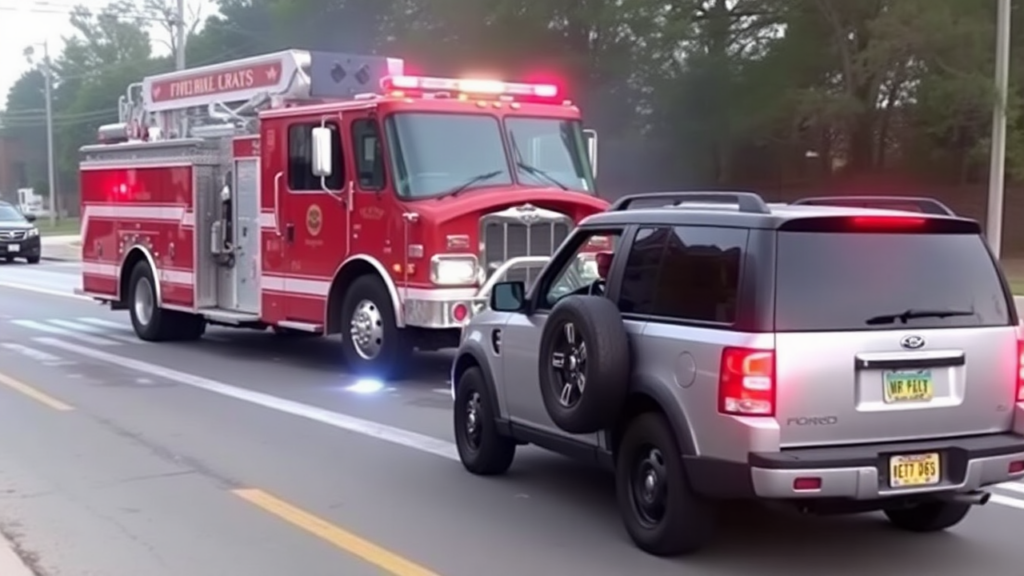Emergency vehicle accidents present unique legal challenges and safety concerns for everyone on the road. A recent collision between a Fresno County fire engine and a Ford Bronco highlights the serious risks when emergency responders race to save lives and property.

The Fresno County Fire Engine Accident
On Thursday, just before noon, a Fresno County Fire engine responding to a grass fire collided with a Ford Bronco at the intersection of American and Maple avenues. The fire truck was operating with emergency lights activated when the Ford Bronco entered the intersection, resulting in a collision between the front of the SUV and the left side of the fire engine.
The impact was severe enough to cause the fire engine to roll over, demonstrating the significant forces involved in such accidents. Both firefighters in the engine, along with the driver of the Ford Bronco, sustained pain-related injuries and were transported to a local hospital for treatment.
Understanding Emergency Vehicle Right-of-Way Laws
California Vehicle Code establishes clear rules regarding emergency vehicles and their right-of-way privileges. When emergency vehicles operate with lights and sirens activated, other drivers must yield the right-of-way and pull to the right side when safely possible.
However, emergency vehicle operators also have responsibilities. They must drive with due regard for the safety of all persons and property, even when responding to emergencies. This means emergency vehicle drivers cannot completely disregard traffic safety rules, though they are granted certain exemptions during emergency responses.
Common Causes of Emergency Vehicle Accidents
Several factors commonly contribute to collisions involving fire trucks, ambulances, and police vehicles:
Driver Awareness Issues: Many drivers fail to notice approaching emergency vehicles due to distractions, loud music, or simply not checking mirrors regularly. The size and weight of fire engines can make it particularly difficult for them to stop quickly or maneuver around obstacles.
Intersection Dangers: Intersections present the highest risk for emergency vehicle accidents. Even with lights and sirens, emergency responders face significant challenges when crossing traffic, as drivers may not have sufficient time to react or see the approaching vehicle until it’s too late.
Weather and Road Conditions: Emergency vehicles must respond regardless of weather conditions, increasing accident risks during rain, fog, or other challenging conditions that affect visibility and road traction.
Equipment and Vehicle Limitations: Fire trucks and other emergency vehicles face unique operational challenges contributing to accidents. Their high center of gravity makes them prone to rollovers during sharp turns or sudden maneuvers. At the same time, their extended length and wide turning radius can create blind spots and navigation difficulties. Additionally, the weight of water tanks and equipment affects braking distances significantly, requiring emergency vehicle operators to anticipate stops well in advance, even during urgent responses.
Legal Implications and Liability Questions
Determining fault in emergency vehicle accidents requires careful analysis of multiple factors. Courts examine whether the emergency vehicle operator exercised due care, whether civilian drivers properly yielded right-of-way, and whether any traffic violations contributed to the collision.
In cases where emergency responders are found to have acted negligently, government agencies may be held liable for damages. However, California’s Government Claims Act requires specific procedures and timing for filing claims against public entities, making prompt legal consultation essential.
Civilian drivers involved in emergency vehicle accidents may also face liability if they failed to yield appropriately or violated traffic laws. Insurance companies often scrutinize these cases, as the presence of an emergency vehicle can significantly impact coverage and settlement negotiations.
Injuries in Fire Truck Accidents
The size and weight of fire engines – often exceeding 40,000 pounds when fully loaded – create substantial injury risks in collisions. Common injuries include:
Occupant Injuries: Firefighters and paramedics in emergency vehicles face unique injury risks due to the vehicle’s height, equipment storage, and the nature of their work positioning during transport.
Civilian Vehicle Occupants: Those in passenger vehicles typically sustain more severe injuries due to the significant size and weight differential between their car and the emergency vehicle.
Secondary Injuries: Rollover accidents, like the one involving the Fresno County fire engine, can cause additional trauma as occupants are thrown around the vehicle interior or struck by loose equipment.
Long-term Complications: Many fire truck accident victims experience complications beyond initial emergency treatment. The psychological trauma of being involved in a collision with emergency responders can lead to anxiety, depression, and post-traumatic stress disorder. Additionally, the sudden, high-impact nature of these accidents often results in soft tissue injuries, spinal complications, and traumatic brain injuries that may not manifest symptoms immediately but can cause chronic pain and disability requiring ongoing medical care and rehabilitation.
Steps to Take After an Emergency Vehicle Accident
If you’re involved in an accident with an emergency vehicle, several immediate actions can protect your interests:
Seek Medical Attention: Even if injuries seem minor, the adrenaline from such accidents can mask severe trauma. Professional medical evaluation ensures proper documentation of injuries and establishes necessary treatment records.
Document the Scene: If possible, photograph vehicle damage, road conditions, traffic signals, and the accident scene. Emergency vehicle accidents often involve complex investigations, making thorough documentation valuable.
Gather Information: Obtain badge numbers, agency information, and contact details for all emergency personnel involved. Standard insurance information exchange may not apply to government vehicles similarly.
Contact Legal Counsel: Emergency vehicle accident cases involve specialized legal considerations, including government liability rules and unique insurance coverage issues that require experienced legal guidance.
Preserve Evidence and Avoid Statements: In the immediate aftermath, avoid making detailed statements about fault or the circumstances of the accident to anyone other than law enforcement. Emergency vehicle accidents often involve multiple investigating agencies, and premature statements can be misinterpreted or taken out of context. Keep all medical records, repair estimates, and correspondence related to the accident organized in one place. If possible, maintain a daily journal documenting your injuries, pain levels, and how the accident affects your daily activities, as this information can be valuable for insurance claims and potential legal proceedings.
Prevention and Road Safety
Both emergency responders and civilian drivers share responsibility for preventing these tragic accidents. Emergency vehicle operators receive specialized training in emergency driving techniques, but cannot prevent all accidents when civilians fail to yield appropriately.
Drivers can reduce emergency vehicle accident risks by remaining alert, checking mirrors regularly, keeping radio volumes reasonable, and understanding proper yielding procedures. When you see or hear an emergency vehicle approaching, safely move to the right and stop until the vehicle passes completely.
The recent Fresno County accident serves as a reminder that emergency responses, while necessary for public safety, carry inherent risks for responders and the public. Understanding these risks and taking appropriate precautions can help prevent similar tragic incidents.
Seeking Legal Assistance
Emergency vehicle accidents involve complex legal issues that require specialized knowledge of government liability, emergency vehicle operations, and traffic laws. If you’ve been involved in an accident, consulting with experienced personal injury attorneys can help protect your rights and ensure proper compensation for injuries and damages.
The unique nature of emergency vehicle accidents means that standard traffic accident procedures may not apply, making professional legal guidance essential for successfully navigating these challenging cases.
Understanding Settlement Values in Emergency Vehicle Accidents
Truck accident settlement calculators can provide valuable insights when evaluating potential compensation in emergency vehicle collision cases. These online tools help estimate settlement ranges by factoring in variables such as medical expenses, lost wages, property damage, pain and suffering, and the severity of injuries sustained.
While fire truck accidents share similarities with commercial truck accidents due to vehicle size and weight, they involve additional complexities, including government liability caps and sovereign immunity considerations. Settlement calculators typically account for economic damages, like hospital bills and rehabilitation costs, and non-economic damages, such as emotional distress and loss of quality of life.
However, these tools should only serve as preliminary guidance, as actual settlement values in emergency vehicle cases depend heavily on specific circumstances, applicable government liability laws, and the strength of evidence regarding fault and damages. Call us now at +1 415-986-4777 to talk to the experts.
Moving Forward
“When you’re involved in an accident with an emergency vehicle, it’s natural to feel confused and overwhelmed, especially when you know the firefighters or paramedics were trying to help others. But please remember that your injuries and your family’s well-being matter too. These cases involve complex government liability laws that are very different from typical car accidents, and insurance companies often try to minimize payouts by claiming emergency vehicles always have the right-of-way. That’s not true under California law. If you or a loved one were injured in this Fresno County accident or any emergency vehicle collision, don’t let anyone pressure you into accepting blame or a quick settlement. You deserve proper medical care and fair compensation for your injuries. We’re here to help you understand your rights and ensure you get the justice you deserve during this difficult time.”- Andy Gillin, GJEL Accident Attorney
If you or someone you love has been injured in an emergency vehicle accident in Fresno County or anywhere in California, don’t face this challenge alone. At GJEL Accident Attorneys, we have decades of experience handling complex cases involving government entities and emergency vehicles.
Our team understands the unique legal hurdles these cases present, and we’re committed to fighting for maximum compensation for your medical bills, lost wages, pain and suffering, and future care needs. Contact us today for a free, no-obligation consultation.
We work on a contingency fee basis, which means you pay nothing unless we win your case. Call us now or visit our website to learn how we can help you move forward confidently and safely. Call us at +1 415-986-4777 or visit our Concord office.
Important Resources and Contact Information
Fresno Police Department Traffic Division
Address: 2323 Mariposa Street, Fresno, CA 93721 Non-Emergency Phone: (559) 621-7000 Traffic Accident Reports: (559) 621-2455 Online Services: City of Fresno Police Department website provides online accident report requests and traffic citation information. Reports are typically available 5-10 business days after the incident.
Fresno County Sheriff’s Office
Address: 2200 Fresno Street, Fresno, CA 93721 Non-Emergency Phone: (559) 600-3111 Traffic Services: Handles accidents on unincorporated county roads and provides collision reports for incidents outside city limits.
California Highway Patrol – Fresno Area Office
Address: 703 B Street, Fresno, CA 93706 Phone: (559) 262-0400 Services: Investigates major traffic accidents, provides collision reports for state highways, and maintains records of accidents involving commercial and emergency vehicles on state routes.
Fresno County Superior Court – Traffic Division
Address: 1100 Van Ness Avenue, Fresno, CA 93724 Phone: (559) 457-2000 Services: Handles traffic citations, provides information on court dates, and processes requests for traffic violation records that may be relevant to accident cases.
California Department of Motor Vehicles – Fresno Office
Address: 1377 W Shaw Avenue, Fresno, CA 93711 Phone: (800) 777-0133 Services: Provides driving records, vehicle registration information, and official documentation that may be needed for insurance claims and legal proceedings.
Additional Emergency and Support Services
Fresno County Emergency Medical Services: (559) 600-3271 Victim Services Program: (559) 600-8654 California Victim Compensation Board: 1-800-777-9229
These resources can help accident victims obtain necessary documentation, understand the investigation process, and access support services during recovery. Always request official accident reports and maintain copies of all documentation related to your emergency vehicle accident case.



 AI-search
AI-search  Email
Email